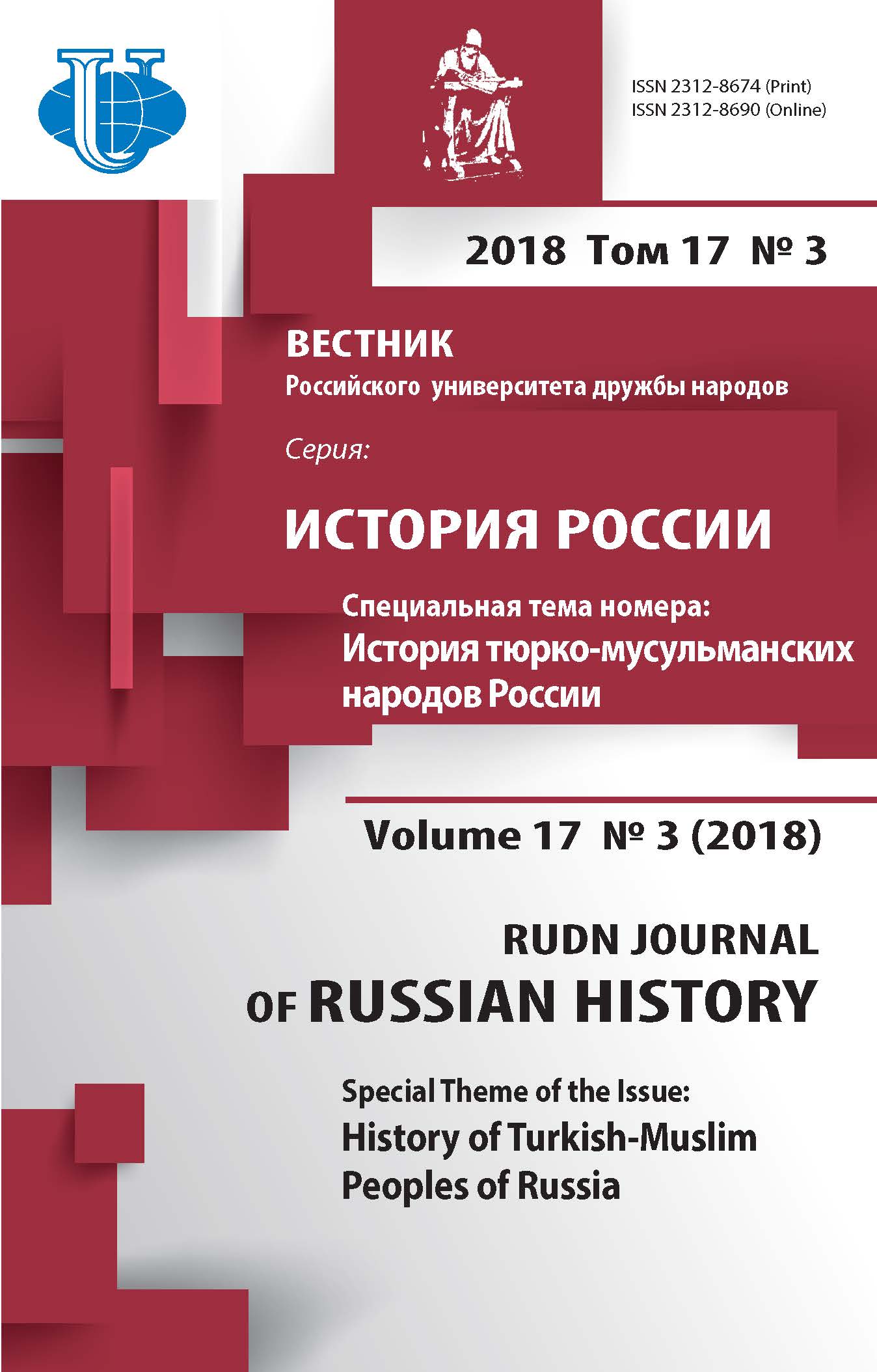Siberian bukharans in the first post-revolutionary decade
- Authors: Datsyshen V.G1
-
Affiliations:
- Siberian Federal University
- Issue: Vol 17, No 3 (2018): HISTORY OF TURKISH-MUSLIM PEOPLES OF RUSSIA
- Pages: 661-674
- Section: HISTORY OF TURKISH-MUSLIM PEOPLES OF RUSSIA
- URL: https://journals.rudn.ru/russian-history/article/view/19129
- DOI: https://doi.org/10.22363/2312-8674-2018-17-3-661-674
Cite item
Full text / tables, figures
Abstract
The article deals with the problems of the Siberian Bukharans’ community in the first decade after the Russian Revolution of 1917. The Bukharans played an important role in the history of Western Siberia for several centuries. But the significance of the Bukhara community in the economic life of Siberia decreased steadily; there took place rapprochement in the form of assimilation with Siberian Tatars. In the early twentieth century, the reforms, revolutionary changes and war became an ordeal for Siberian Bukharans. As a result of the state policy, both imperial and Soviet, the most important factor in preserving the Bukhara identity - the Bukhara volost - was destroyed. After the end of the civil war in Siberia, the Bukharans in the bulk were in opposition to the Soviet power. In many areas of Siberia in the early twentieth century there was a drop in the population of Bukharans. The largest and most organized community of the Siberian Bukharans in Soviet Russia was preserved in the Tarsky district of the Siberian territory - more than 11 thousand people. In the focus of the research there are problems of the economic, political and cultural development of the Bukharans in the Tarsky district in the mid-1920s. The documents found by the author indicate the degradation of the Siberian Bukharans’ economy. It was caused by the fact that after the victory of the Soviet government, a significant part of them did not connect their future with Siberia anymore, the Bukharans expected permission to leave the USSR, mainly to Turkey. The article introduces new scientific archival documents which reflect the policy of the state in connection with the desire of the Bukharans to leave the USSR. The central Soviet government did not allow this, but ordered to improve the work with this group of the population. Despite the fact that the Soviet leaders in Siberia tried to improve the economic and cultural situation of the Bukharans, they failed to completely eliminate the “resettlement sentiments”. From 1927, the Soviet government ceased to recognize the Bukharans as a separate ethno-social group, including them in the number of Siberian Tatars or for some time using the name “Tatar-Bukharans”.
About the authors
Vladimir G Datsyshen
Siberian Federal University
Author for correspondence.
Email: dazishen@mail.ru
79, Svobodny Psospect, Krasnoyarsk, 660041
References
- “Godovye itogi na hozyajstvenno-politicheskom fronte Sibiri 1922−1923.” [Annual results on the economic and political front of Siberia 1922−1923] Zhizn’ Sibiri. Novonikolaevsk: Sibrevkom Press, 1923 (in Russian).
- Fayzrakhmanov, G.L. “Buharcy v Zapadnoy Sibiri v XVII − nachale XX vekov.” [Bukharans in Western Siberia in the 17th − early 20th centuries] Vestnik Bashkirskogo universiteta [Bulletin of Bashkir University], no. 3 (2005): 69−71 (in Russian).
- Fayzrakhmanov, G.L. Istoriya sibirskih tatar (s drevnejshih vremen do nachala XX veka) [The history of Siberian Tatars (from ancient times to the early 20th century)]. Kazan: Tatarskoe knizhnoe izdatel’stvo Press, 2007 (in Russian).
- Klyueva, V.P. “Sibirskie buharcy Tobol’skoy gubernii (konec XVII − XIX vv.): demograficheskiy analiz.” [Siberian Bukharans of Tobolsk Governorate (end of the 17th − 19th centuries.): Demographic analysis] In Slovcovskie chteniya − 2001: tezisy dokladov i soobshcheniy nauchno-prakticheskoy konferencii, g. Tyumen’, 13−15 noyabrya 2001 g. [Slovcovskiy read − 2001: theses of papers and messages of scientifically-practical conference, Tyumen, 13−15 November 2001], 95−96. Tyumen: Tyumen Press, 2001 (in Russian).
- Korusenko, S.N. “Sovetskaya vlast’ i nacional’nye men’shinstva v seredine 1920-h gg. (na primere Tarskogo okruga sibirskogo kraya).” [Soviet power and national minorities in the mid-1920s. (on the example of the Tarsky District of the Siberian Territory)] Herald of Omsk University. Series: Historical Sciences, no. 4 (2014): 91−102 (in Russian).
- Korusenko, S.N. “Volost’ kak instrument sohraneniya identichnosti gruppy (na primere sibirskih buharcev).” [Volost as an instrument of preserving the identity of the group (on the example of Siberian Bukharans)] Herald of Omsk University. Series: Historical Sciences, no. 2 (2016): 196−206 (in Russian).
- Korusenko, S.N. “Sibirskie buharcy: dinamika chislennosti i rasselenie (XVII−XX vv.).” [Siberian Bukharans: the dynamics of numbers and resettlement (17th − 20th centuries)] Journal of Historical, Philological and Cultural Studies, no. 22 (2008): 485−491 (in Russian).
- Minina, S.A., ed. Mezhehtnicheskie svyazi Prienisejskogo regiona [Interethnic relations of the Enisey region], 1917−1992. Vol. 2. Krasnoyarsk: Arhivnoe agentstvo administracii Krasnoyarskogo kraya Press, 2007 (in Russian).
- Patkanov, S. Statisticheskie dannye, pokazyvayushchie plemennoy sostav naseleniya Sibiri, yazyk i rody inorodcev [Statistical data showing the composition of the tribal population of Siberia, language and clans of indigenous dweller]. Vol. 1. St. Petersburg; SH. Bussel Press, 1912 (in Russian).
- Shneyder, A.R., and Dobrova-Yadrintseva, L.N. Naselenie Sibirskogo kraya [The population of the Siberian region]. Novosibirsk: SIBKRAYIZDAT Publ., 1928 (in Russian).
- Tikhomirova, M.N. “Pishcha tarskih buharcev (ulenkulevskij kust) v seredine XX – nachale XXI vekov.” [Food of Tara Bukharans (Ulenkulov bush) in the mid-20th − early 21th centuries] Fundamental’nye issledovaniya [Fundamental research] 8, no. 11 (2014): 1835−1839 (in Russian).
- Valeev, F.T. “Buharcy sibirskie.” [Bukharans Siberian] Tatarskaya enciklopediya [Tatar Encyclopedia], 509. Kazan: Institute of the Tatar Encyclopedia Publ., 2002 (in Russian).
- Vilkov, O.N., and Datsyshen, V.G. “Buharcy.” [Bukharans] In Enciklopedicheskiy slovar’ po istorii kupechestva i kommercii v Sibiri [Encyclopaedic dictionary on the history of merchants and commerce in Siberia], 105−107. 2 vols. Novosibirsk: Academic Publishing House “Geo”, 2011 (in Russian).
- Yarkov A.P., and Garifullin I. B. “Buharcy v Zapadnoj Sibiri.” [Bukharans in Western Siberia] Topos. Literaturno-filosofskiy zhurnal [Topos. Literary and philosophical journal], 2004. http://www.topos.ru/article/2394 (in Russian).
- Gosudarstvenny arhiv Novosibirskoy oblasti (thereafter – GANO) [State Archives of the Novosibirsk Region], f. Р-47, op. 1, d. 276.
- GANO, f. Р-47, op. 1, d. 75.
















